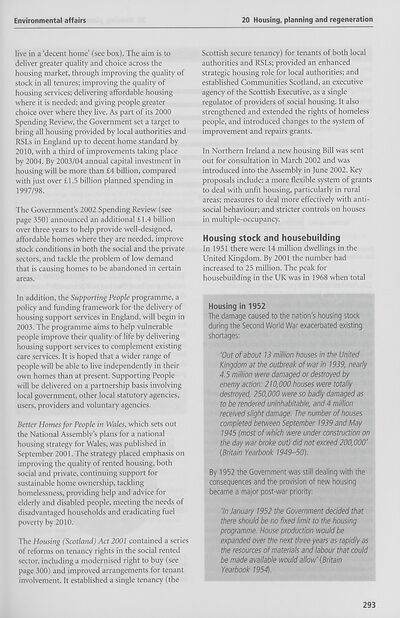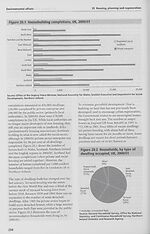Download files
Complete book:
Individual page:
Thumbnail gallery: Grid view | List view

Environmental affairs
20 Housing, planning and regeneration
live in a ‘decent home’ (see box). The aim is to
deliver greater quality and choice across the
housing market, through improving the quality of
stock in all tenures; improving the quality of
housing services; delivering affordable housing
where it is needed; and giving people greater
choice over where they live. As part of its 2000
Spending Review, the Government set a target to
bring all housing provided by local authorities and
RSLs in England up to decent home standard by
2010, with a third of improvements taking place
by 2004. By 2003/04 annual capital investment in
housing will be more than £4 billion, compared
with just over £1.5 billion planned spending in
1997/98.
The Government’s 2002 Spending Review (see
page 350) announced an additional £1.4 billion
over three years to help provide well-designed,
affordable homes where they are needed, improve
stock conditions in both the social and the private
sectors, and tackle the problem of low demand
that is causing homes to be abandoned in certain
areas.
In addition, the Supporting People programme, a
policy and funding framework for the delivery of
housing support services in England, will begin in
2003. The programme aims to help vulnerable
people improve their quality of life by delivering
housing support services to complement existing
care services. It is hoped that a wider range of
people will be able to live independently in their
own homes than at present. Supporting People
will be delivered on a partnership basis involving
local government, other local statutory agencies,
users, providers and voluntary agencies.
Better Homes for People in Wales, which sets out
the National Assembly’s plans for a national
housing strategy for Wales, was published in
September 2001. The strategy placed emphasis on
improving the quality of rented housing, both
social and private, continuing support for
sustainable home ownership, tackling
homelessness, providing help and advice for
elderly and disabled people, meeting the needs of
disadvantaged households and eradicating fuel
poverty by 2010.
The Housing (Scotland) Act 2001 contained a series
of reforms on tenancy rights in the social rented
sector, including a modernised right to buy (see
page 300) and improved arrangements for tenant
involvement. It established a single tenancy (the
Scottish secure tenancy) for tenants of both local
authorities and RSLs; provided an enhanced
strategic housing role for local authorities; and
established Communities Scotland, an executive
agency of the Scottish Executive, as a single
regulator of providers of social housing. It also
strengthened and extended the rights of homeless
people, and introduced changes to the system of
improvement and repairs grants.
In Northern Ireland a new housing Bill was sent
out for consultation in March 2002 and was
introduced into the Assembly in June 2002. Key
proposals include: a more flexible system of grants
to deal with unfit housing, particularly in rural
areas; measures to deal more effectively with anti¬
social behaviour; and stricter controls on houses
in multiple-occupancy.
Housing stock and housebuilding
In 1951 there were 14 million dwellings in the
United Kingdom. By 2001 the number had
increased to 25 million. The peak for
housebuilding in the UK was in 1968 when total
Housing in 1952
The damage caused to the nation's housing stock
during the Second World War exacerbated existing
shortages:
'Out of about 13 million houses in the United
Kingdom at the outbreak of war in 1939, nearly
4.5 million were damaged or destroyed by
enemy action: 210,000 houses were totally
destroyed, 250,000 were so badly damaged as
to be rendered uninhabitable, and 4 million
received slight damage. The number of houses
completed between September 1939 and May
1945 (most of which were under construction on
the day war broke out) did not exceed 200,000'
{Britain Yearbook 1949-50).
By 1952 the Government was still dealing with the
consequences and the provision of new housing
became a major post-war priority:
'In January 1952 the Government decided that
there should be no fixed limit to the housing
programme. House production would be
expanded over the next three years as rapidly as
the resources of materials and labour that could
be made available would allow'{Britain
Yearbook 1954).
293
20 Housing, planning and regeneration
live in a ‘decent home’ (see box). The aim is to
deliver greater quality and choice across the
housing market, through improving the quality of
stock in all tenures; improving the quality of
housing services; delivering affordable housing
where it is needed; and giving people greater
choice over where they live. As part of its 2000
Spending Review, the Government set a target to
bring all housing provided by local authorities and
RSLs in England up to decent home standard by
2010, with a third of improvements taking place
by 2004. By 2003/04 annual capital investment in
housing will be more than £4 billion, compared
with just over £1.5 billion planned spending in
1997/98.
The Government’s 2002 Spending Review (see
page 350) announced an additional £1.4 billion
over three years to help provide well-designed,
affordable homes where they are needed, improve
stock conditions in both the social and the private
sectors, and tackle the problem of low demand
that is causing homes to be abandoned in certain
areas.
In addition, the Supporting People programme, a
policy and funding framework for the delivery of
housing support services in England, will begin in
2003. The programme aims to help vulnerable
people improve their quality of life by delivering
housing support services to complement existing
care services. It is hoped that a wider range of
people will be able to live independently in their
own homes than at present. Supporting People
will be delivered on a partnership basis involving
local government, other local statutory agencies,
users, providers and voluntary agencies.
Better Homes for People in Wales, which sets out
the National Assembly’s plans for a national
housing strategy for Wales, was published in
September 2001. The strategy placed emphasis on
improving the quality of rented housing, both
social and private, continuing support for
sustainable home ownership, tackling
homelessness, providing help and advice for
elderly and disabled people, meeting the needs of
disadvantaged households and eradicating fuel
poverty by 2010.
The Housing (Scotland) Act 2001 contained a series
of reforms on tenancy rights in the social rented
sector, including a modernised right to buy (see
page 300) and improved arrangements for tenant
involvement. It established a single tenancy (the
Scottish secure tenancy) for tenants of both local
authorities and RSLs; provided an enhanced
strategic housing role for local authorities; and
established Communities Scotland, an executive
agency of the Scottish Executive, as a single
regulator of providers of social housing. It also
strengthened and extended the rights of homeless
people, and introduced changes to the system of
improvement and repairs grants.
In Northern Ireland a new housing Bill was sent
out for consultation in March 2002 and was
introduced into the Assembly in June 2002. Key
proposals include: a more flexible system of grants
to deal with unfit housing, particularly in rural
areas; measures to deal more effectively with anti¬
social behaviour; and stricter controls on houses
in multiple-occupancy.
Housing stock and housebuilding
In 1951 there were 14 million dwellings in the
United Kingdom. By 2001 the number had
increased to 25 million. The peak for
housebuilding in the UK was in 1968 when total
Housing in 1952
The damage caused to the nation's housing stock
during the Second World War exacerbated existing
shortages:
'Out of about 13 million houses in the United
Kingdom at the outbreak of war in 1939, nearly
4.5 million were damaged or destroyed by
enemy action: 210,000 houses were totally
destroyed, 250,000 were so badly damaged as
to be rendered uninhabitable, and 4 million
received slight damage. The number of houses
completed between September 1939 and May
1945 (most of which were under construction on
the day war broke out) did not exceed 200,000'
{Britain Yearbook 1949-50).
By 1952 the Government was still dealing with the
consequences and the provision of new housing
became a major post-war priority:
'In January 1952 the Government decided that
there should be no fixed limit to the housing
programme. House production would be
expanded over the next three years as rapidly as
the resources of materials and labour that could
be made available would allow'{Britain
Yearbook 1954).
293
Set display mode to:
![]() Universal Viewer |
Universal Viewer | ![]() Mirador |
Large image | Transcription
Mirador |
Large image | Transcription
The item on this page appears courtesy of Office for National Statistics and may be re-used under the Open Government Licence for Public Sector Information.
| Britain and UK handbooks > UK: The official yearbook of the United Kingdom of Great Britain and Northern Ireland > 2003 > (327) |
|---|
| Permanent URL | https://digital.nls.uk/204927361 |
|---|
| Attribution and copyright: |
|
|---|---|
| Description | Three volumes of 'UK: The official yearbook of the United Kingdom of Great Britain and Northern Ireland', published annually by the Office of National Statistics from 2002-2005. |
|---|---|
| Shelfmark | GII.11 SER |
| Description | Three titles produced by the British Government from 1954-2005 describing 'how Britain worked'. They are: 'Britain: An official handbook' (1954-1998), 'Britain: The official yearbook of the United Kingdom' (1999-2001), and 'UK: The official yearbook of the United Kingdom of Great Britain and Northern Ireland' (2002-2005). These 50 reports provide an overview of Britain's economic, social and cultural affairs, its environment, international relations, and the systems of government. They give an impartial summary of government policies and initiatives, and explain how public services are organised. |
|---|---|
| Additional NLS resources: |
|

